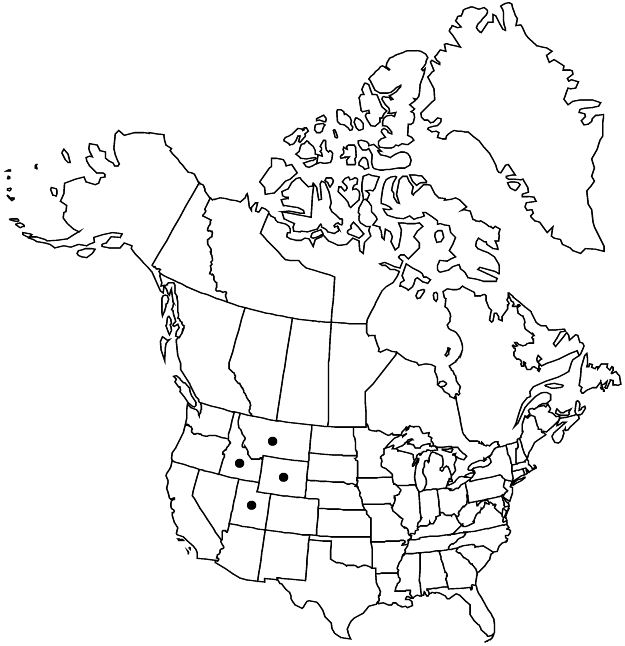Difference between revisions of "Ivesia gordonii var. wasatchensis"
Novon 17: 323. 2007.
FNA>Volume Importer |
imported>Volume Importer |
||
| (6 intermediate revisions by 2 users not shown) | |||
| Line 28: | Line 28: | ||
|elevation=2000–3200 m | |elevation=2000–3200 m | ||
|distribution=Idaho;Mont.;Utah;Wyo. | |distribution=Idaho;Mont.;Utah;Wyo. | ||
| − | |discussion=<p>Variety wasatchensis is more broadly defined here than the “wasatchensis” of N. H. Holmgren (1997b). The variety is most distinct in the greater Wasatch Range and in the western Uinta Mountains, where plants are generally larger than other varieties with larger leaves, more elongated leaflets, and multi-headed inflorescences. Less distinctive populations extend along the Idaho-Wyoming border to southwestern Montana. Variety wasatchensis merges with var. gordonii at low elevations in Montana and Wyoming, and with the high-elevation phase assigned here to var. gordonii in Utah.</p> | + | |discussion=<p>Variety wasatchensis is more broadly defined here than the “wasatchensis” of N. H. Holmgren (1997b). The variety is most distinct in the greater Wasatch Range and in the western Uinta Mountains, where plants are generally larger than other varieties with larger leaves, more elongated leaflets, and multi-headed inflorescences. Less distinctive populations extend along the Idaho-Wyoming border to southwestern Montana. Variety wasatchensis merges with <i></i>var.<i> gordonii</i> at low elevations in Montana and Wyoming, and with the high-elevation phase assigned here to <i></i>var.<i> gordonii</i> in Utah.</p> |
|tables= | |tables= | ||
|references= | |references= | ||
| Line 37: | Line 37: | ||
-->{{#Taxon: | -->{{#Taxon: | ||
name=Ivesia gordonii var. wasatchensis | name=Ivesia gordonii var. wasatchensis | ||
| − | |||
|authority=N. H. Holmgren ex Ertter & Reveal | |authority=N. H. Holmgren ex Ertter & Reveal | ||
|rank=variety | |rank=variety | ||
| Line 52: | Line 51: | ||
|publication year=2007 | |publication year=2007 | ||
|special status=Endemic | |special status=Endemic | ||
| − | |source xml=https:// | + | |source xml=https://bitbucket.org/aafc-mbb/fna-data-curation/src/2e0870ddd59836b60bcf96646a41e87ea5a5943a/coarse_grained_fna_xml/V9/V9_361.xml |
|subfamily=Rosaceae subfam. Rosoideae | |subfamily=Rosaceae subfam. Rosoideae | ||
|tribe=Rosaceae tribe Potentilleae | |tribe=Rosaceae tribe Potentilleae | ||
Latest revision as of 22:56, 5 November 2020
Stems usually greenish, ± erect, (1–)1.5–4 dm, sometimes sparsely villous, minutely glandular, often glandular-pubescent. Basal leaves 9–20(–25) × 1–2(–3) cm; leaflets 7–13(–18) mm, glabrous or sparsely hirsute or villous marginally. Inflorescences 10–50(–70)-flowered, usually branched, 2–8(–11) cm diam., glomerules (1–)2–6(–10), ± capitate. Flowers 9–12 mm diam.; epicalyx bractlets 2–4 mm; hypanthium 2.5–4(–4.5) × 2.5–4(–5) mm; sepals 3–5(–6) mm, acute to obtuse; anthers sometimes red-margined.
Phenology: Flowering summer.
Habitat: Talus slopes and outcrops, in montane and subalpine conifer woodlands
Elevation: 2000–3200 m
Distribution

Idaho, Mont., Utah, Wyo.
Discussion
Variety wasatchensis is more broadly defined here than the “wasatchensis” of N. H. Holmgren (1997b). The variety is most distinct in the greater Wasatch Range and in the western Uinta Mountains, where plants are generally larger than other varieties with larger leaves, more elongated leaflets, and multi-headed inflorescences. Less distinctive populations extend along the Idaho-Wyoming border to southwestern Montana. Variety wasatchensis merges with var. gordonii at low elevations in Montana and Wyoming, and with the high-elevation phase assigned here to var. gordonii in Utah.
Selected References
None.